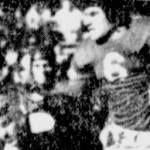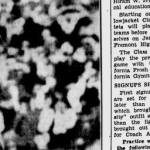
=======================================================
Michigan State quarterback PAUL DERRICKSON intercepts a forward pass while Santa Clara fullback JOHNNY HANNA (# 18), the junior whose blocked extra point had secured the Broncos’ 7-6 victory over the Spartans in 1938, watches in dismay during the high-profile NCAA non-conference affair contested at Kezar Stadium in San Francisco on November 11, 1939.
=======================================================
Although the UNIVERSITY of SANTA CLARA had improved greatly under the preceding head coach, it was only after the promotion of the mastermind LAWRENCE T. “BUCK” SHAW in 1936 that the little independent from the San Francisco Bay Area in northern California completed its stunning rise to national prominence on the football gridiron.
A former two-way lineman who had been a three-year starter at tackle for the legendary Knute Rockne while at the University of Notre Dame from 1919 until 1921, Shaw guided Santa Clara to the unexpected record of eight wins against just one loss his first year at the helm. Only a 9-0 loss to powerful Texas Christian University and its consensus All-America passer Sammy Baugh in their final game of the 1936 season had prevented the upstart Broncos from becoming the only major college football team in all the land to post an unblemished record with no losses or ties that term. After concluding the regular season ranked # 6 by the Associated Press in its year-end poll, Santa Clara then upset the heavily-favored Louisiana State Tigers (who were rated at # 2 team by the AP and # 1 by the prestigious Williamson System) at the 1937 Sugar Bowl Game.
Santa Clara followed that success up by allowing its opponents to score a grand total of exactly nine points while winning all nine of its football games the very next season, as well. Included among these triumphs for the stingy Broncos (whose defense permitted a paltry 25 yards rushing per game that term) was yet another victory over the LSU Tigers, this time as a result of the 6-0 victory in the 1938 Sugar Bowl contest. Santa Clara finished tied with the Notre Dame Fighting Irish for the # 9 ranking in the final poll for the 1937 NCAA season issued by the Associated Press but that was before the Broncos had downed the Tigers (ranked # 8 in that same final poll put out by the AP) on New Year’s Day in New Orleans for the second consecutive time.
Shaw’s seemingly unstoppable Santa Clara team, which was known to use an intricate offensive scheme involving a good deal of backfield trickery as well as the forward pass, ripped off six consecutive victories to begin its 1938 NCAA schedule. The Broncos rose to # 5 in the weekly Associated Press poll after beating the Michigan State Spartans 7-6 on the road in East Lansing in late October of that year but fell out of the rankings after upset losses to arch-rival Saint Mary’s in the Little Big Game that was by 60,000 spectators at Kezar Stadium in San Francisco as well as little-known Detroit Mercy. It is said that the missed extra point that enabled Detroit Mercy to win 7-6 cost Santa Clara a third successive appearance in the annual Sugar Bowl Game and the tired Broncos squad, itself, chose to decline a potentially lucrative invitation to travel to Dallas, Texas, and compete in the 1939 Cotton Bowl.
===================================================






===================================================
(Associated Press – Berkeley Daily Gazette, Monday, November 13, 1939) … Santa Clara’s consensus All-America center JOHNNY SCHIECHL (# 32) observes as Broncos sophomore right halfback WARD HEISER (# 6) attempts to make headway running the reverse against the Michigan State Spartans during the NCAA non-conference tilt at Kezar Stadium in San Francisco on November 11, 1939.
===================================================
Santa Clara lost eight of its eleven first team players from the ’38 Broncos squad, including consensus All-America tackle ALVORD WOLFF and four others whose professional rights were reserved at the 1939 National Football League Draft. Also departing from the Santa Clara side that had finished 6-2-0 in 1938 were another four useful seniors from the second team, as well. There was, however, still a great deal of experienced and/or pro caliber material returning in addition to the encouraging class of talented sophomores on hand and hungry for action as Shaw readied his troops to meet the comming 1939 NCAA campaign.
The ’39 Broncos were spearheaded by a trio of very well-seasoned returning starters, seniors all — center JOHNNY SCHIECHL, right end BILL ANAHU and quarterback RAY MCCARTHY.
McCarthy, who would later be selected by the Pittsburgh Steelers in the 15th round (# 133 overall) of the 1940 NFL Draft, had tied for the Santa Clara team lead as a junior in 1938 by scoring three touchdowns (two receiving, one rushing). As a sophomore, the signal caller / blocking back had paved the way for the only touchdown scored by either team in the 1938 Sugar Bowl contest by catching a 20-yard pass to leave the ball on the LSU Tigers 9-yard line. It was also versatile McCarthy, who was cited as Third Team All-Pacific Coast by the Associated Press at the end of his senior campaign, who threw the pass that accounted for the Broncos’ lone touchdown in the 1939 season-opener against the University of Utah, as well.
Anahu, nicknamed “Hawaiian Bill” because of the fact he hailed from Honolulu and destined to be chosen by the Cleveland Rams in the 8th round (# 65 overall) of the 1940 NFL Draft, had been honored as Second Team All-Pacific Coast by the NEA Sports Syndicate in 1938 and would become a First Team All-Pacific Coast selection of both the Associated Press and United Press in 1939. The Santa Clara left end was also recognized as Second Team All-America by the International New Service at the conclusion of his senior season, as well. Heading into the contest against the UCLA Bruins that year, Anahu was in the midst of a two-game streak having hauled in touchdown passes versus the Stanford Indians and Michigan State Spartans on consecutive weekends.
===================================================









===================================================
Schiechl, the 220-pounder who was as much devastating blocker at center on offense as he was a big-play linebacker on defense, was easily Santa Clara’s most highly regarded player. The product of Balboa High School from the working class Excelsior District in San Francisco was thought by many in 1939 to be the most dominant lineman on the entire West Coast and went into the history books as the nation’s consensus All-America center that year after being cited as First of Second Team by eight major organizations. Schiechl, who registered an offensive touchdown for the Broncos as a junior in 1938 after running 34 yards with a lateral from Anahu against the visiting Arkansas Razorbacks, was the 13th overall player taken at the 1940 NFL Draft when plucked in the second round by the Philadelphia Eagles.
Santa Clara had two other quality seniors, fullback JACK ROCHE and tackle NICK STUBLER, who would be snapped up at the 1940 NFL Draft. The productive Roche, who caught the touchdown pass from McCarthy in the Broncos’ 1939 season-opener opposite the Utah Utes and later notched rushing touchdowns in back-to-back games against the Purdue Boilermakers and Stanford Indians, respectively, was picked in the tenth round (# 81 overall) by the Chicago Cardinals. The rock-solid Stubler, whom both the Associated Press and United Press regarded as Third Team All-Pacific Coast in 1939, was grabbed in the fourteenth round (# 122 overall) by the Pittsburgh Steelers.
===================================================









===================================================
The ’39 Broncos were also blessed by the presence of three skilled left halfbacks, all of whom were capable of passing the football forward to devastating effect. DICK CLARK had thrown no fewer than four touchdown passes during Santa Clara’s 27-0 defeat of the University of Arizona as a sophomore in 1938 and was expected to be first string but a critical fourth quarter fumble in the Broncos’ 1939 season-opener would result in Clark spending much of the first half of his junior campaign out of favor with the coaching staff. Clark would re-emerge later in the term, though, to toss important touchdown passes in successive games against the Stanford Indians and Michigan State Spartans.
JIM JOHNSON, who, as a junior, had been the only player on either side to cross the goal line with the football during the game against the University of San Francisco in 1938, quickly established himself in the pivotal left halfback spot as a senior. Santa Clara’s 187-pound “triple-threater” would be hailed as Second Team All-Pacific Coast by the Associated Press and Third Team All-Pacific Coast by the United Press in 1939 after throwing for two touchdowns, rushing for another and adding a 34-yard field goal (in the 7-3 loss to Texas A&M), as well. Johnson was ultimately chosen by the powerhouse Chicago Bears in the 13th round (# 119 overall) of the 1941 NFL Draft.
Perhaps the most naturally gifted of the Broncos’ three left halfbacks was none other than sophomore KEN CASANEGA. It was the 175-pounder from Oakland’s Castlemont High School who had come off the bench to throw the very late touchdown pass that had enabled Santa Clara to salvage a 13-13 tie with the San Francisco Dons in the Broncos’ third game on their 1939 NCAA schedule. Casagena scored Santa Clara’s last six points in the 27-7 massacre of the Stanford Indians and capped off his first varsity season by rushing and passing for one touchdown each during the Broncos’ 41-0 rout of Loyola University of Los Angeles.
===================================================









===================================================
Santa Clara left halfback KEN CASANEGA (# 2), who hauled one punt against the University of California back 67 yards for what proved to be the winning touchdown against the University of California after having previously returned another punt 50 yards to set up the first score of the game during the Broncos’ 13-7 triumph over the Golden Bears in 1941, became the third overall player taken at the 1942 National Football League Draft when selected in the first round by the Pittsburgh Steelers.
